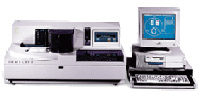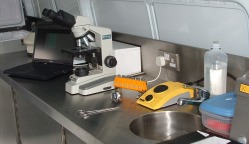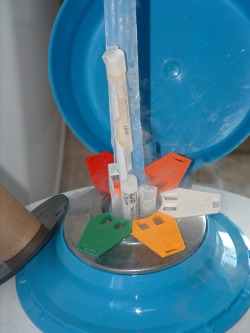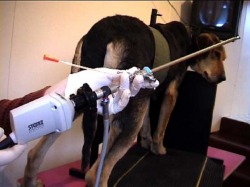Progesterone Testing

The most common cause of a missed conception is improper timing of mating.
Many methods have been used in the past to determine the ideal time to implant, including vaginal smears, vaginoscopy, electrical conductivity, vaginal discharge appearance, but all of these do not accurately reflect the hormone changes that cause these external signs. The most precise method to determine the correct timing of mating is accurate progesterone testing.
At Trade Kennels we installed Immulyte 1000, immunoassay system, the only equipment tested, collaborated and certified for use of canine serum. We will have results ready for you in 45 minutes and can forward them to you immediately. The ideal time for taking a sample from the female is early in the morning, before first feeding. You can post the blood sample then to the lab by Swift post, it enable us to give you the accurate result by noon.
Progesterone testing isn't as simple as determining a number – there are many factors that impact to determine the best time to breed. If you are interested in progesterone and variations, please keep an eye on our website, the publication on the above matter will be published in the near future.
Progesterone Guidelines nmol/L & ng/ml correlation (IDEXX Laboratories 2017)
Concentration of Concentration of Estimate for Ovulation Estimated Time for Breeding
Progesterone in Progesterone in (no. of days) (no. of days)
nmol/L ng/ml
0-2 nmol/L 0-0.63ng/ml Baseline concentration, Not applicable
too early to estimate
3-6 nmol/L 0.94-1.89ng/ml Minimum of 2 days before Earliest estimated window for breeding
ovulation is expected. Results is from 4-6 days, but could be longer
of 3-4 nmol/L may persist for a
a week or longer.
7-12 nmol/L 2.2-3.77ng/ml Minimum of 1 day before Estimated window for breeding is 3-5
ovulation is expected. days but could be longer.
13-18 nmol/L 4.09-5.66ng/ml Ovulation is impending or has Estimated window for breeding is
just occurred. 2-4 days
19-31 nmol/L 5.97-9.75ng/ml Ovulation recently occurred. Estimated window for breeding is 1-3 days
32-64 nmol/L 10.06-20.13ng/ml Ova/Eggs have matured, Estimated window for breeding is 0-2 days
optimal potential for fertility
65-90 nmol/L 20.44-28.30ng/ml Ova/Eggs have matured but Breed at once 0-1 days
aging, decreased potential
for fertility
>90 nmol/L >28.30 ng/ml Too late or very reduced
potential for fertility
Collection and Freezing of Semen

An appointment is necessary to arrange to have your dog’s semen collected and frozen. This could be done at our premises or in your own kennels. We only use the imported extenders of the Camelot system and produce pelleted semen packaged into screw-cap vials, each vial being one insemination (breeding) unit.
It is important to consider the recent breeding history of your sire when contemplating having his semen frozen. Ideally he has had a semen collection or mating in the past 2 months. If it has been six months or more without sexual activity the initial semen sample may be of inferior quality to freeze.
In such cases it may be worthwhile to collect the sire 7 days prior to the freezing appointment to stimulate the spermatogenic cycle. Ideally he hasn’t mated in the past three days. Multiple collections available; all the sires are kept in the secure heated kennels with access to outdoor paddocks or we can accommodate any boarding requirements on demand.
Trade Genetics always have a seasonal bitch available. By using a female in heat you increase the chances for a successful collection and potentially increase the number of breeding units in the collection, decreasing the cost per unit in each particular collection. For toy breeds we recommend bringing a teaser bitch with you. (Be sure to travel them in separate compartments – ideally car and trailer!)
Sires should be at least one year old and, depending on concurrent illness may be successfully collected past ten years. However, semen from older dogs may not “recover” as well during post thaw.
The male's semen is collected. This is achieved by manual stimulation. The collector needs to obtain the second fraction of the ejaculate (the milky, sperm rich portion) stopping the collection when the third fraction starts (watery in appearance) which consists of prostatic fluid.
It will only take approximately 15 minutes to collect and to analyse the semen and to collect the blood sample if required for export. After a freeze is complete and final pellets formed, we thaw one pellet to assess its post thaw motility of the semen.
Storage of Semen

Semen is stored in large tanks containing liquid nitrogen, at -150 C. All the tanks are inspected on a daily basis to ensure there is no nitrogen loss and the semen is kept at a stable temperature.
Pelleted semen is stored in a small screw cap bottle called a vial (cryovial) with ID information about each donor and the date it has been frozen. Each vial contains enough semen for one insemination. Occasionally, there might be a necessity to use two vials, if the collection was performed at later stages in life of a sire and the post thaw motility is under the optimal range. The vials are clipped onto aluminum canes, identified by numbers. The tanks are topped up with liquid nitrogen as required.
There is no time limit on storage of the frozen semen as long as the conditions are maintained stable throughout the period, whether it is one day or 50 years. Insurance can be purchased for additional fee to the owner of the semen. ( Insurance provider is FBD Insurance - please talk to us, if you are interested.)
Trancervical Insemination

Transcervical insemination is an alternative method of inseminating with frozen semen but for fresh semen, chilled semen, etc this method is widely recommended and generally successful. When frozen canine semen is placed into vaginal tract, the conception rate is lower then for transcervical insemination and surgical implant. We have performed a few inseminations with frozen semen which resulted in normal size litter but we would not recommend using this way if alternative ways are available. (Opinions may vary in different clinics.)
The bitch should have her rear end elevated for the artificial insemination procedure. This positioning facilitates the semen's deposition and flow to the cervical opening, a necessary for the semen being in position to be "pumped" into the uterus. The inseminator should digitally stoke the roof of the vaginal tract for 1-2 minutes after insemination. This technique simulates the tie of a natural breeding. The bitch's rear should be elevated for 2-3 minutes post-insemination.
The necessity to bypass the cervix and place the semen into the uterine lumen is beneficial in improving the conception rates in numerous situations. These include the use of frozen semen, fresh cooled semen, poor semen quality and in situations where examination of the bitch's uterus is desired.
Two methods are used to achieve the intrauterine deposition of semen, the transcervical insemination and the surgical insemination. These techniques each have their own usage guidelines and one does not replace the other as has been mistakenly represented to dog breeders.
The transcervical insemination (TCI) is performed with the bitch in a standing position. No sedation nor anesthesia is required. A fiber optic cystourethoscope is used vaginally to visualize the opening to the cervix. A flexible catheter is maneuvered through the cervix into the uterus. It is important that the breeder realize that the veterinarian is not visualizing the inside of the uterus and this technique does not allow for evaluation of the uterus.
The TCI procedure is visualized on a television monitor and does allow for examination of the vaginal tract, however. The semen is gently pushed through the catheter from a syringe. The veterinarian can visualize that the semen flows easily into the uterus and does not flow back into the vaginal tract.
The transcervical insemination does not replace the surgical insemination as it does not allow for uterine evaluation, but is a significant improvement over the vaginal method of artificial insemination. The TCI is recommended for any type semen, especially frozen and fresh-cooled and can significantly increase conception when poor quality semen and lowered sperm numbers are used. The TCI technique should be used in bitches less than 5 years of age where there is not a reason to suspect uterine changes or uterine disease.
Surgical Implant

The surgical method of artificial insemination is especially useful when breeding "middle age" and older bitches (5 years of age and older) (This matter seems to be one of the few in reproduction, on which all researchers agree). For over 60 days every season progesterone affects the uterine lining and causes inflammation, whether she is pregnant or not, subsequently changing it.
The changes to the uterine lining can affect conception in many ways. The endometrial cysts can affect the semen's ability to reach the fallopian tubes where conception occurs (regardless of the method of insemination). The cystic changes can also prevent implantation of the fertilized ova, which occurs 17-18 days after ovulation and can inhibit placental development and growth.
A surgical insemination is a minor surgical procedure that allows the surgeon to inject the semen directly into the uterus. The skin is cut at the position where the muscle tissue is at its thinnest to ensure quickest possible healing time. As the surgeon has the uterus in his hands, cysts, uterine wall thickness and muscular texture can be evaluated. There is no more accurate method to perform this vital examine.
The surgical procedure is performed under sterile conditions.
The bitch is given an injection of anaesthetic. An endotracheal tube is placed and the bitch is connected to a gas anesthetic. Even though the total surgical time is usually no longer than 10-15 minutes the bitch is connected to surgical monitoring.
A 2-3 inch incision is made on the abdomen through the skin and underlying muscle. The uterus is isolated and evaluated. The semen, whether fresh collected, fresh chilled or frozen, is inseminated though a small hypodermic needle into the uterus. The veterinary surgeon can see and feel the uterus fill as the semen is deposited. There is no incision in the uterus proper. The incision is sutured and in most cases the bitch is sent home within an hour post-surgically. Our veterinary clinic will keep the bitch overnight before sending her back to the kennels or home to ensure the bitch is well, there is no post operational reaction to anaesthetic, the stitches are dry and there is no inflammation.
A bitch that has had surgical inseminations is not more prone to needing a caesarean section nor having whelping difficulties. Having a surgical insemination does not decrease the number of times a bitch can be bred. A surgical insemination should be considered anytime there is a reason to evaluate the uterus (bitches 5 years and older) or where the semen being used can benefit from intrauterine implantation. At Trade Kennels we recommend surgical implant and have achieved a remarkable 92% conception rate, while natural breeding, vaginal insemination and transcervical insemination, performed under the similar consequences have not prove to optimise the breeding potential of bitches and the conception rate is still in its mid 70ies. (74%)
